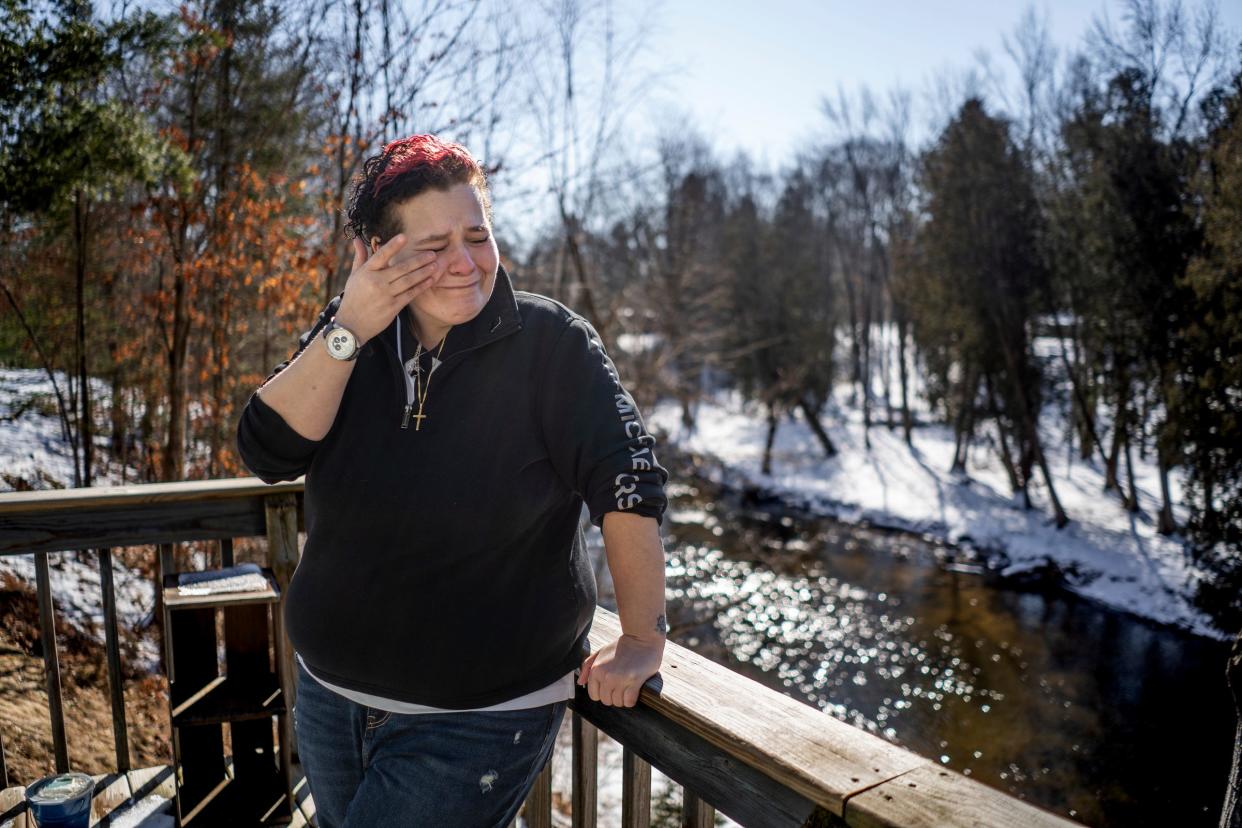Tiny fungal spores in Michigan's woods nearly harmless for most, but deadly for some
The last time Ron Pritchard heard his son Ian's voice was just before Thanksgiving of last year. Then his son was placed on a ventilator.
Ian Pritchard, 29, of Boyne City, had come to the emergency room of McLaren North Michigan Hospital in Petoskey about a week earlier, complaining of lower abdominal pain. Doctors believed he had an infected prostate, and prescribed antibiotics. Within days, Ian was back in the ER, the pain intensified, the pills not working. Doctors then found an abscess on his prostate and admitted him. Then they found much more.
Ian had only about 25% of his lung capacity.

"He never complained of shortness of breath; he never let us know he wasn't breathing right," Ron Pritchard said. "He just let us know that he was tired — and of course you are going to be tired when you are not taking in the proper amount of oxygen."
A mysterious ailment that can take months to show up
Ian Pritchard had blastomycosis, a fungal infection caused by breathing spores that especially live in damp, woodsy areas like northern Lower Michigan. The spores like warm, moist areas in which they can thrive, making the lungs and internal organs of an animal — or a human — almost ideal.
Most who breathe the spores don't get sick at all; a few get cold or flu-like symptoms and then get better in short order. But rarely, particularly among the immunocompromised, the fungus spreads and causes serious illness — attacking the lungs, other organs, bones, the skin, the brain or spinal cord. And those infected can go weeks or months before developing symptoms.
Michigan last year suffered the largest known outbreak of the disease ever, with more than 120 people sickened and one killed when the fungus cropped up at a sprawling paper mill in Escanaba. Overall, the state had four blastomycosis deaths in 2023.
Ian Pritchard's blastomycosis settled in his lungs, which "looked like Swiss cheese before it was all over," his father said.
By Nov. 28, Ian was life-flighted from Petoskey to Henry Ford Hospital in Detroit because it had a more advanced heart-lung machine called an ECMO. The machine acts as the patient's heart and lungs, removing carbon dioxide from blood and recirculating oxygenated blood.
Ian Pritchard was on Henry Ford's ECMO machine longer than anyone there could remember — more than two months — as medical staff fought back against the blastomycosis with powerful antifungal medications. But the damage was extensive. His lungs kept collapsing, and air pockets had developed in his chest cavity. He became septic, his blood infected. Ian Pritchard died on Feb. 3, just six days from his 30th birthday.
"It just blows my mind how this happened," his father said. "We just were not expecting it at all. We thought, 'OK, he's going to get his abscess drained; when that's clear, he will be fine and back home to us.
"Ian said to us, 'I want to be home by Thanksgiving because I don't want to mess up your holiday.' He was intubated by Thanksgiving."
Michigan's blastomycosis case numbers low, but hard to pin down
States that track blastomycosis report only one or two cases per 100,000 population a year. Deaths from the disease are similarly rare, with the federal Centers for Disease Control and Prevention finding 1,216 blastomycosis-related deaths occurred in the U.S. from 1990 to 2010.
But the case numbers are heightened in the Upper Midwest, with northern Wisconsin seeing up to 40 cases per 100,000 population.
The Michigan Department of Health and Human Services tracks hospitalizations and deaths caused by fungal diseases such as blastomycosis. Dr. Natasha Bagdasarian, chief medical executive for the state of Michigan, acknowledged the numbers are hard to pin down.

"We know that blastomycosis is something that's not very common," she said. "But it's also difficult to have exact numbers on how many people get blasto, because the symptoms can be similar to other types of respiratory infection."
Those who tend to do worse with the infection have compromised immune systems, such as those with AIDS or on chemo or steroid therapies; or those who've had organ transplants. Pregnant women also seem more susceptible, according to the data.
But for those with healthier immune systems, blastomycosis can present like another respiratory infection or pneumonia, and they recover.
"So it's not something that's tested for or detected," Bagdasarian said.
State health department data shows:
In 2020, there were 20 blastomycosis cases in Michigan — 16 confirmed and four probable — with two deaths.
In 2021, 16 cases (eight confirmed, eight probable) and one death.
In 2022, 32 cases (20 confirmed, 12 probable) and two deaths.
But last year Michigan's numbers exploded, with the largest blastomycosis outbreak in the scientific record at the Billerud paper mill. The accounting is not final, but more than 120 cases there pushed the state's 2023 provisional total to 162 cases, with four deaths, including one contract worker at Billerud. Pritchard's is the state's first known blastomycosis death of 2024.
Billerud paper mill blastomycosis outbreak 'was a first of its kind'
In early March 2023, the Billerud paper mill in Escanaba had a few workers go out on sick leave with respiratory symptoms. The Swedish-owned paper giant is the largest employer in the Upper Peninsula, with nearly 900 workers.
The condition of one or two of the workers worsened, requiring hospitalization. Doctors were treating them for pneumonia, but they weren't getting better. Then additional tests showed they had blastomycosis.
As word spread among the employees, more with respiratory symptoms got tested. Eventually, about 120 workers were confirmed blastomycosis cases, with at least 13 workers requiring hospitalization, some for many weeks.

After the Gladstone contractor worker's death, Billerud officials in April closed the plant for three weeks as the U.S. Centers for Disease Control and Prevention and other federal and state investigators conducted tests. A deep-cleaning of the plant was conducted, with replacement of air filters in the HVAC system.
The case was unprecedented. Blastomycosis isn't communicable — one infected person isn't going to infect another person.
"Typically, if there is an environmental exposure, we talk about the attack rate, how many vulnerable people will end up with a particular disease," Bagdasarian said. "This was highly unusual in terms of how many people, even within the exposure, developed symptoms.
"This was something that was a first of its kind."
No signs of the blastomycosis spores were ever found in the mill, Billerud officials said.
"It seems most likely that there was material that was highly contaminated and there was some mode of transportation that resulted in folks being exposed to that highly contaminated material," Bagdasarian said.
The unusual case is still under study from investigators with the CDC and National Institute of Occupational Safety and Health.
Fungal infections wreak havoc on Marion woman — 'I wanted to die'
Courtney Cirone had lived with chronic health conditions, but her health "took a crazy turn" around 2020.

"You can't breathe well, you have chronic cough," she said. "Your body hurts — I have rheumatoid arthritis, but my body hurt in a totally different way."
Cirone lost more than 100 pounds in a year.
"You can't keep food down, food doesn't taste the same," she said. "I'm having to have $14,000 in dental work because you vomit so much, your teeth pay a toll."Doctor's visits, trips to the hospital for years brought no resolution.
"I told my doctors, 'If this is my quality of life, please let me die,' " Cirone said in tears. "I wanted to die every day."
Cirone's doctors zeroed in on a mysterious lung fungus as the root of her condition in July 2022. At that same time, her beloved cat became ill and "died in her arms." Her veterinarian concluded the cat had contracted blastomycosis.
"I called my doctor and said, 'It's blasto,' " Cirone said. "And they checked me for blasto and it was positive."
Cirone was also found to have a fungal spore infection that's very similar, known as histoplasmosis. Antifungal medications have relieved many of her worst symptoms, but spots on some of her internal organs caused by the fungi have not yet gone away, she said.
"I am not in the clear," she said.
Cirone is a friend of Ron Pritchard's. When she learned of Ian's illness, she was heartbroken.

"I knew how he was suffering," she said.
Ian's parents look back — was his dog's death a clue?
In hindsight, Ian Pritchard may have been sick for over a year, his father, Ron, said.
"He had been losing weight for a year or more — he had dropped down to 120 pounds, if that," Ron Pritchard said. "And he was 5-7, 5-8, he wasn't very tall.
"We noticed it for a while, and we would say, 'You need to eat something.' But he would eat all the time. He would eat dinner and come back a couple of hours later, make peanut butter and jelly sandwiches, and eat those. He felt healthy."
Around April, Ian Pritchard was treated for an abscess behind his larynx — a somewhat unusual condition, but later he seemed fine. It was only in the weeks just before he went to the emergency room with abdominal pain that Ian complained of being tired all the time, Ron said.
"But he was a line cook, and that's a pretty rough job; you have to be on your toes all the time," his father said. "And he worked about 45 minutes from where we lived. We thought it was the tiring job and the long drive."
One potential piece of the puzzle nags at Ron Pritchard. His son had a dog, a black Labrador mix, who developed respiratory symptoms, constant coughing that turned to choking and gagging. He took the dog to the veterinarian, and was told her health was too far gone. The dog was euthanized in the fall of 2022, less than six months before Ian's larynx abscess was diagnosed.
"We are just speculating — we don't know; we'll never know," Ron said. "But the dog was probably the first indication that something was wrong."
Ian Pritchard's dog, and Courtney Cirone's cat, may indeed have been health harbingers.
"I am an infectious disease physician by background," Bagdasarian said. "For years, I have taken care of patients in the hospital with what we call atypical pneumonia, where we are searching for a cause of pneumonia. And one of the questions that as an infectious disease doctor I routinely ask is about pets that get sick. Because that is sometimes the sentinel, a sort of alarm bell for this potentially being blastomycosis."
She noted that dogs often accompany their owners on walks through wooded, moist areas, with their nose to the ground, sniffing and inhaling the leaf litter. "If you are exposing yourself to an area that has a lot of blastomycosis, it is possible that your dog could get a higher burden of exposure than you," she said.
Keep going to the woods, pay attention to your health
Bagdasarian doesn't want to see people stop enjoying the woods and water that makes Michigan what it is.
"My advice for those in the community is not to freak out, not to worry about this particular pathogen if you are someone with a normal, healthy immune system."
But those with compromised immune systems should consider that they are potentially at risk of such spores in the areas where they thrive.
"If you develop concerning symptoms, seek medical attention right away — and tell your provider about any exposures that you've had that could indicate either exposure to something like blasto or another atypical pathogen that can impact folks with weakened immune systems," she said.
"If you are someone with a normal, healthy immune system, live your life. But be mindful of atypical, unusual symptoms, and if you have them, seek medical attention."
Cirone said she believes blastomycosis is far more prevalent in Michigan than the numbers indicate, and believes doctors should do a better job looking for it and reporting it to public health officials — who should then do more to inform the public of the risks.
"If we demand to know what's in our water, we have the right to know what's in our air — especially if it's killing us," she said.
Ron Pritchard said he's willing to tell his son's story to raise awareness.

"Ian was funny; he was a jokester," he said. "He liked to make people laugh and to laugh himself. He was very intense — when he really believed in something or someone, he would really get behind it or them.
"He was very talented in whatever it was he had the mind to pursue, and what he gravitated to was cooking. He was just a great kid, a great guy. I was very proud of him.
"If I have to lose my son to this, then I hope and pray we can use it as an opportunity to make people aware of how widespread blastomycosis is, and how deadly it can be."
For more information on blastomycosis, go to cdc.gov and search "blastomycosis."
Contact Keith Matheny: kmatheny@freepress.com.
This article originally appeared on Detroit Free Press: A fungal spore prevalent in Michigan's forests is a killer for some
